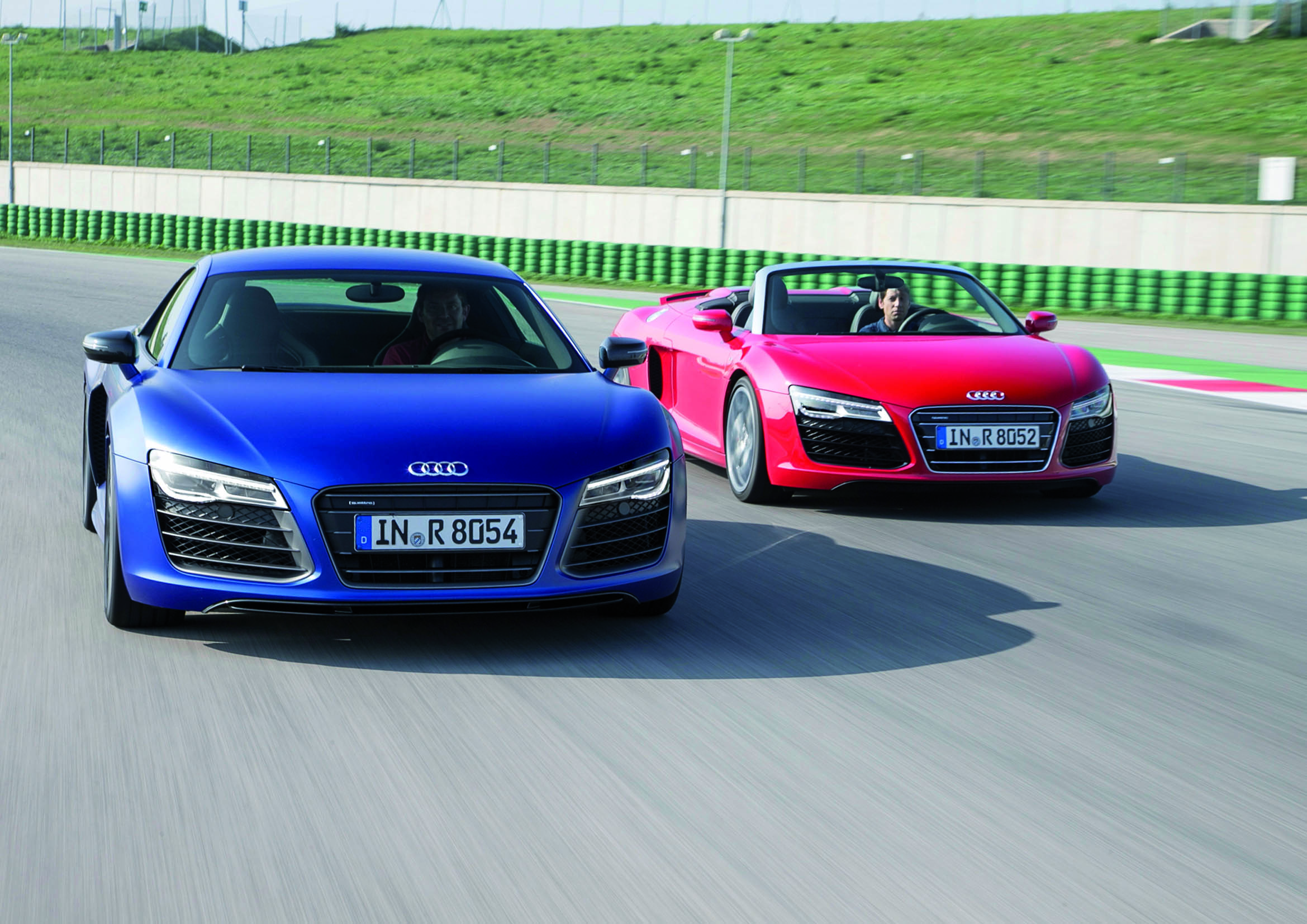 By John LeBlanc
By John LeBlanc
RIMINI, Italy – Messing with success can be a scary ordeal for designers. Imagine an architect asked to do a makeover of Toronto’s iconic CN Tower or the industrial designer given the job of designing the next Apple iPhone? Egad. Talk about pressure.
The same anxiety must have filled Audi’s product design studios when it came time for the German automaker to update its successful R8 supercar — first seen in 2005. Beginning with its show car predecessor, the LeMans show car from 2003, the R8 has become the face of the brand’s design resurgence. And as a mid-engine two-seater with all-wheel-drive (that can be had for about half the price of the Lamborghini Gallardo it shares its aluminum spaceframe with), the Audi R8 has become one of the most accessible supercars you can buy.
When the new 2014 R8 V8 and R8 V10 lineup arrives in Canada next spring, you’ll be hard pressed to notice the differences from a distance. Most of the changes Audi’s quattro GmbH group (the in-house organization responsible for developing and building Audi’s RS performance models and the R8, along with the automaker’s factory racing efforts, most notably its 24 Hours of LeMans sports cars) have wrought are about saving weight or making the R8 a better driver’s car.
Externally, changes to the new R8 hardtop Coupe and cloth-top convertible Spyder have been kept to a minimum. Up front, the corners of the R8’s signature “single frame” grille have been tapered at its corners. Out back, the rear air-diffuser — bracketed by large, round tailpipes — has been tweaked. Audi introduced full-LED headlights to the industry on the R8 four years, and the 2014 version gets an LED design for its taillights as well, including what Audi calls “dynamic” turn signals that run from the inside out to indicate the direction the car is turning.
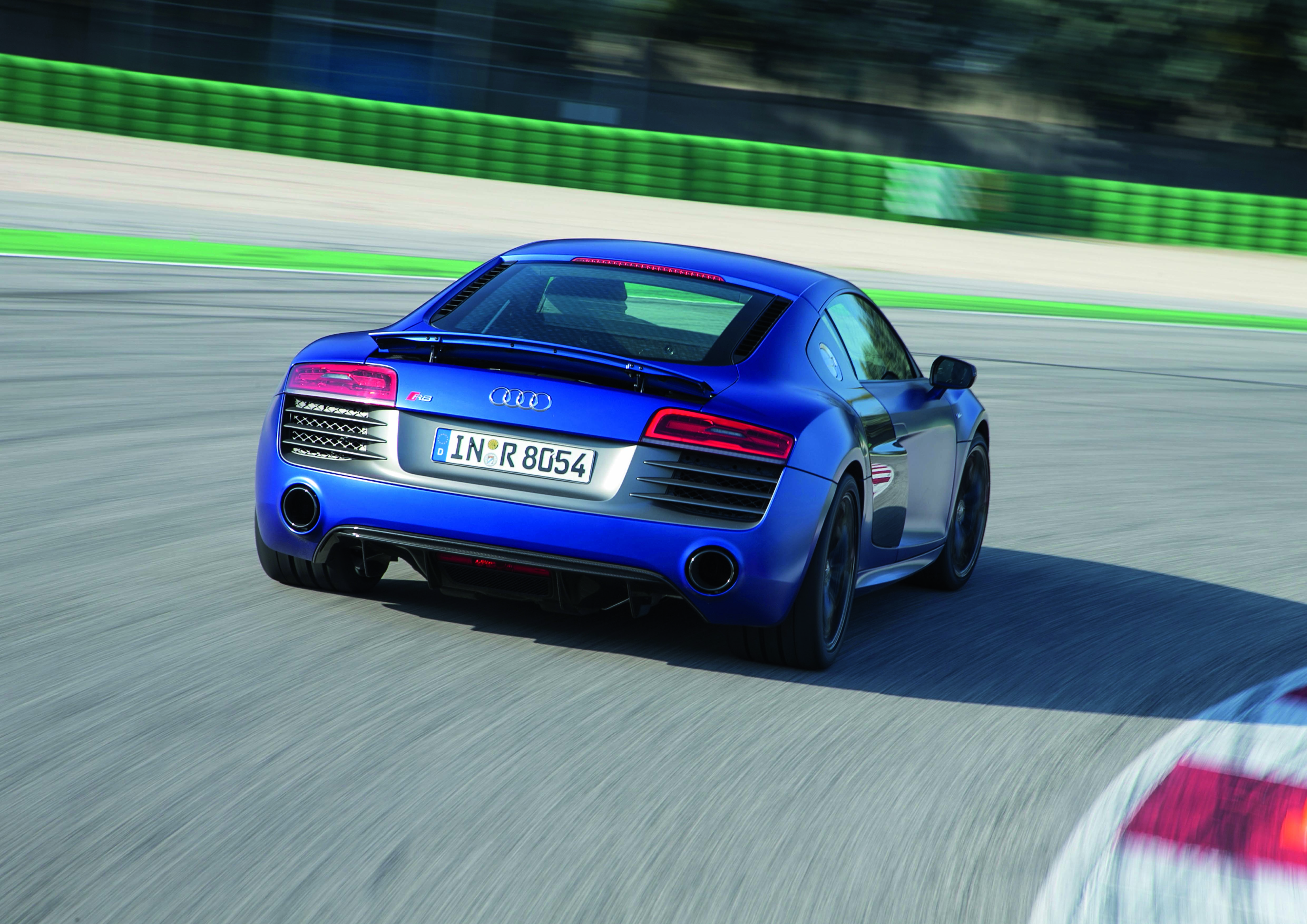
Like a lot of automakers these days, Audi is looking at ways to remove weight from vehicles for better performance, driving dynamics and fuel economy. And while the R8 already uses an aluminum spaceframe body — which its maker says weighs just
210 kilograms, or about 40 per cent less than a comparable steel structure — Audi is using lightweight carbon fiber-reinforced polymer (CFRP) pieces for the 2014 edition’s front spoiler, vertical side blades, engine cover and some interior trim bits as well.
Equally subtle are the new 2014 R8’s interior alterations. Chrome detailing has been added to many interior control and trim elements. The infotainment system has been brought up to contemporary connectivity standards, and the automatic gearbox’s paddle shifters have been made larger for ease of use — like I said, subtle.
Beyond the minor weight savings and styling tweaks, the “big” news for the 2014 R8 is its new automatic transmission. Replacing the unrefined six-speed R tronic automated manual transmission that originated from the R8’s sister model, the Lamborghini Gallardo, the new seven-speed dual-clutch auto is optional on the R8 V8 (where a six-speed manual is still standard) and mandatory on the R8 V10. Many supercar owners demand a stick. But, objectively, the S tronic is the better ‘box. Employing a new launch control feature, the S tronic makes all R8s quicker.
With its 4.2-litre eight-cylinder making 430 horsepower and 317 pound-feet of torque, the S tronic-equipped R8 V8 Coupe takes only 4.3 seconds to go from 0-100 km/h — 0.3 seconds swifter than the outgoing R tonic. The next-rung-up R8 V10 Coupe (with 525 h.p and 391 lb-ft on tap from its 5.2 L 10-cylinder) scoots from rest to 100 km/h in only 3.6 seconds, and can go 14 km/h faster than the R8 V8’s 300 km/h top speed.
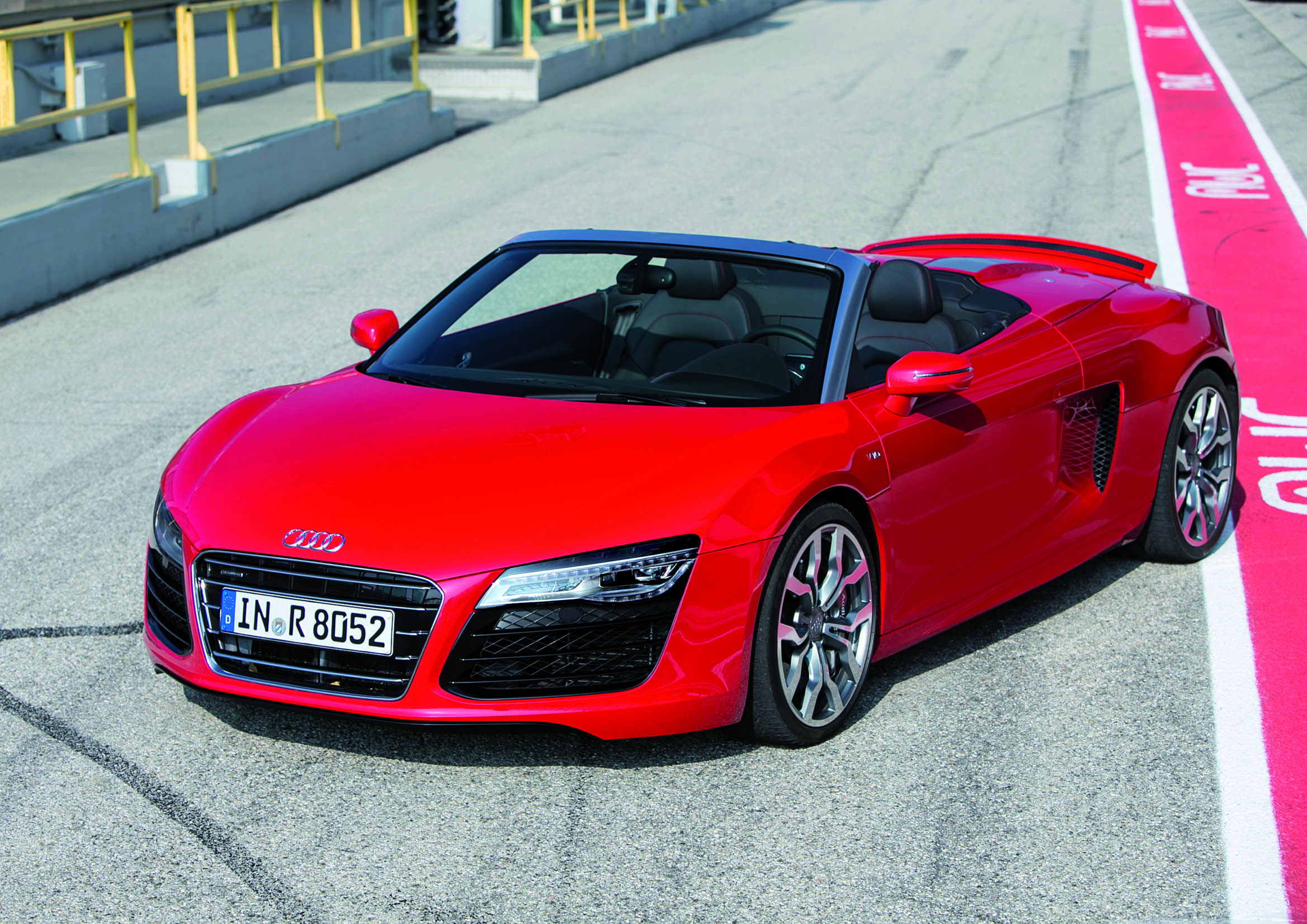
And then there’s the all-new R8 V10 Plus model. Effectively replacing the low-volume R8 V10 GT Coupe and Spyder, the new topline R8 (that hasn’t been signed-off for Canada yet), offers 10 hp less than the outgoing GT, but the same 398 lb-ft rating. With the S tronic gearbox, Audi says it shaves one-tenth of a second off the “regular” V10 Coupe’s 0-100 km/h time, now down to 3.5 seconds. Few R8 owners sweat over fuel bills. But Audi says the new S tronic betters the old R tronic in fuel economy too, on average, down 0.9 L/100 km, ranging from 12.4L/100 km for the R8 V8 to 14.9 for the V10 Plus.
Compared to other supercars, the R8 continues to offer a relatively roomy cockpit, though. And Audi hasn’t messed with that either. The R8’s comparatively long wheelbase delivers plenty of room for driver and passenger. Its front trunk can handle up to 100 L of luggage, and Audi claims you can get a pair of golf bags behind the seats of the Coupe. With its standard all-wheel-drive system, Audi brags the R8 is a supercar you can drive year-round. And those claims were certainly put to the test during the one day I had to test-drive the new 2014 R8 V8 and V10 models, which ended up being drenched with a constant rain.
Perhaps taking into account some criticism that the outgoing R8 was too conservative in its driving characteristics compared to more high-strung, rear-wheel-drive supercars like the Ferrari 458 or McLaren MP4-12C, Audi says the suspension of the flagship V10 Plus Coupe has been “decidedly tuned for dynamics”. Beyond the V8 models, the V10 gets unique spring and shock tuning with a corresponding tweak of its front axle camber rates. But after an afternoon driving in rain on Adriatic coastal roads, just outside Rimini, Italy, I’m happy to report that despite some suspension changes, Audi hasn’t messed with the R8’s confident-inspiring ride and handling.
As per the original, the new R8’s on-road handling leans towards understeer. Which is a surprise if you consider the Audi’s AWD is rear biased (normally, 85 per cent of engine torque goes to the rear wheels, but up to 30 per cent can go to the front rubber when traction is needed there). But one advantage the R8 has over some of its supercar rivals is its magnetorhelogical shock system.
Optional on the 2014 R8 V8, standard on the R8 V10, the active suspension automatically adjusts the responses of the shock absorbers to what the driver is doing and the road surface underneath. Overall, ride quality is firm in any R8 — but not uncomfortable. And with the quality of pavement on one of our test-drive routes questionable at best, the Audi supercar absorbed all the bumps and cracks with nary a shake or rattle.
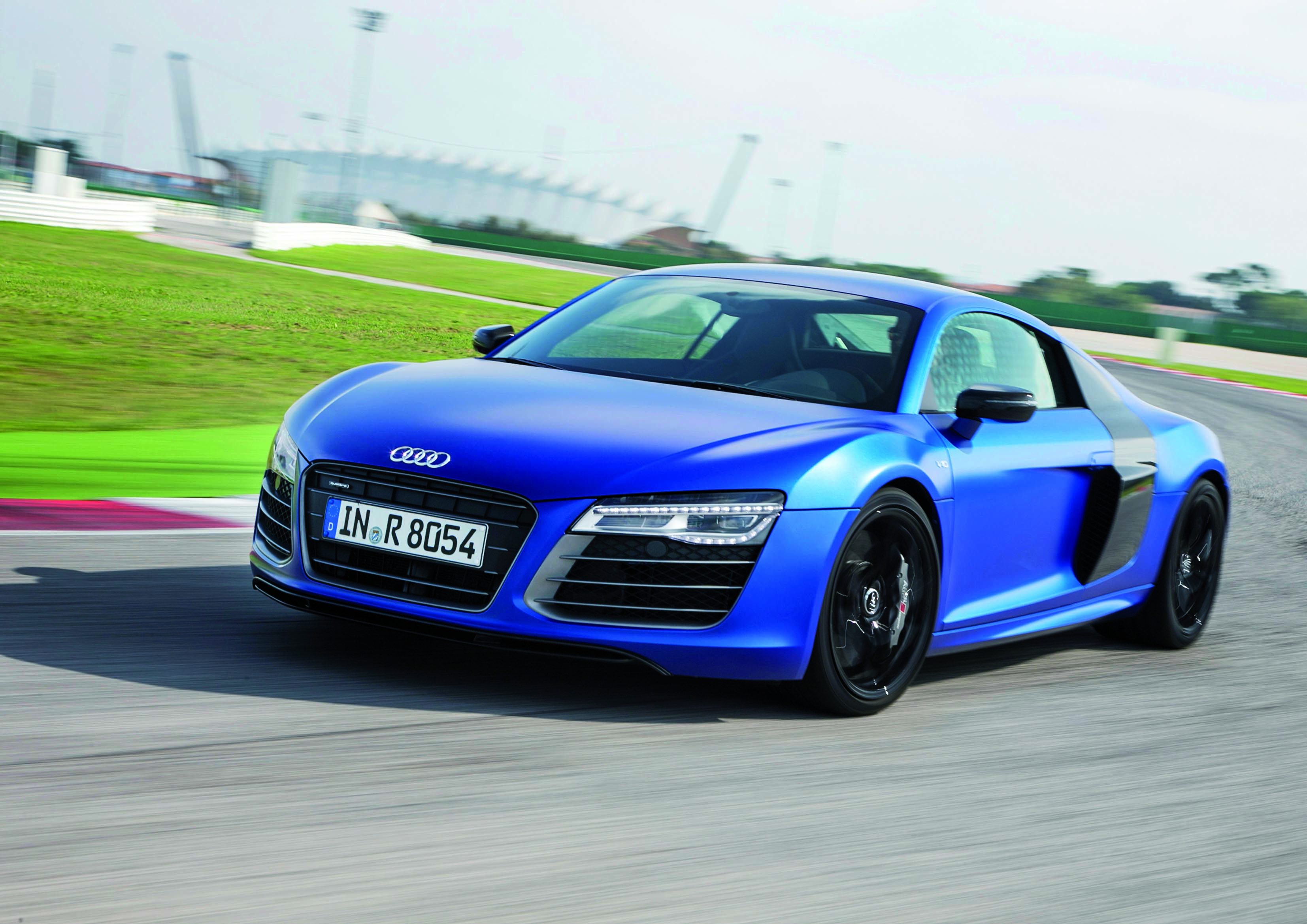
Some of the “super” found in supercars like the Audi is the expectation that owners can take their vehicles to a race track to be exercised as advertised. Now, you could say it was unfortunate that in the few laps Audi had allocated each of us to drive the topline R8 V10 Plus Coupes at the Misano World Circuit (better known as a motor bike track, and home to Audi-owned Ducati) there was non-stop rain. Buy seeing how I make my living evaluating cars, and not racing them, a wet track is the quickest (and safest) way to get to a vehicle’s handling limits.
With the rain creating large, freestanding water on most corners, about halfway through my warm-up lap, I managed to get my R8 V10 Plus Coupe fully sideways. But, between the supercar’s AWD, various e-nannies and a titch of driver skill, the R8 V10 righted itself, and proceeded to loop the circuit in a relatively drama-free fashion.
With a better understanding of the wet track’s adhesion limits — or lack thereof — I was able to push the Audi supercar. The understeer I found on wet public roads could be easily dismissed with a snatch of the R8’s steering wheel, requisite tap on the brakes and mandatory stomp on its accelerator. It helped that the Audi supercar’s weight is rear-biased, with a 57:43 rear to front ratio. What also helped is the new S tronic ‘box. Unlike the older R tronic, gear changes aren’t limited to sequential only. Like Porsche’s PDK, you can drop from from seventh to second cog in one shift.
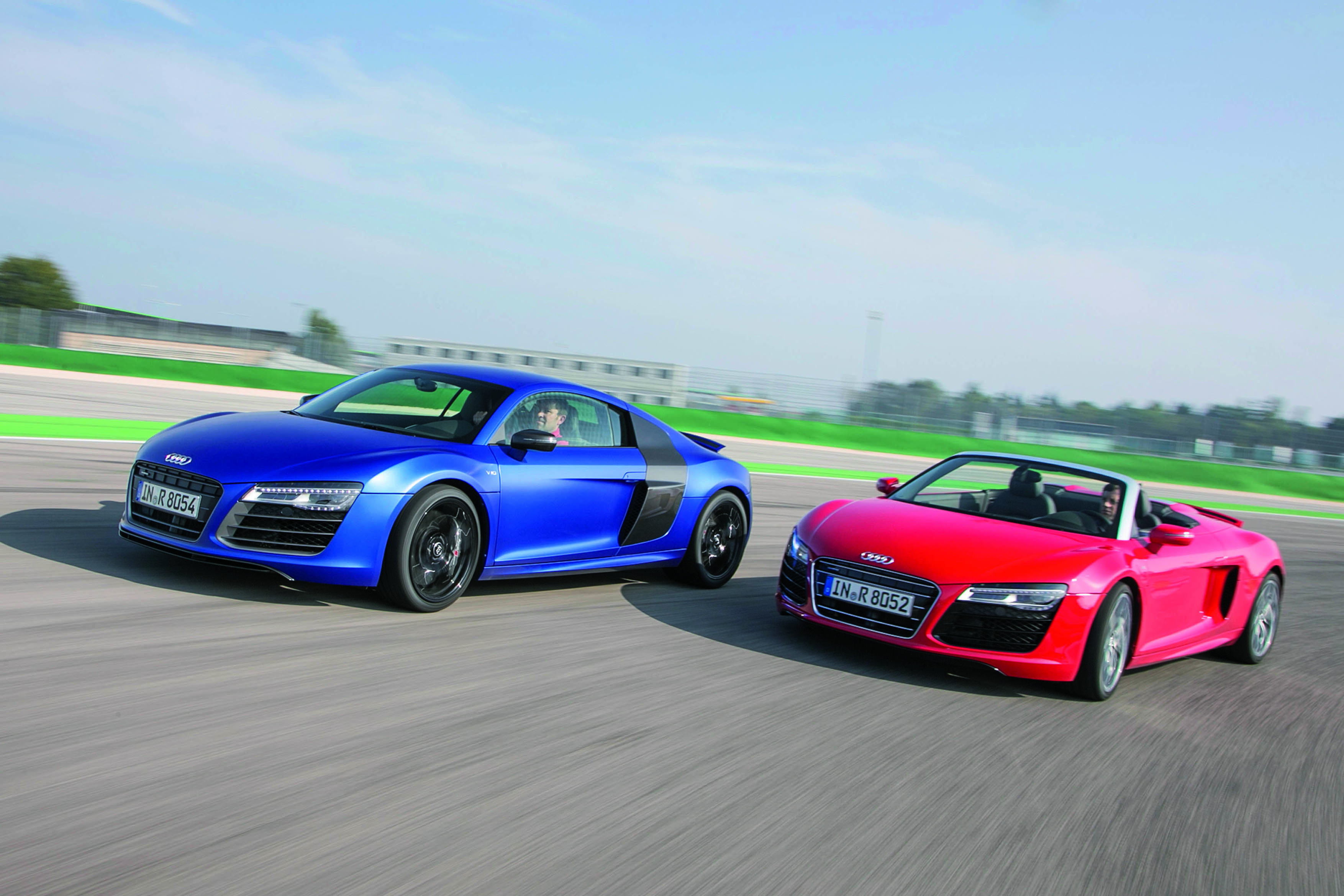
Also impressive were the R8 V10 Plus’s standard carbon fiber-ceramic brakes. Braking from 200 km/h into puddle-filled corners at the track was handled with aplomb. Audi says all four discs are internally vented and perforated, and their wave design saves 12 kgs in weight.
Like other industrial design successes, Audi’s kept the fundamental values of its R8 supercar intact. With its roomy cabin and AWD, the Audi makes any drive at any time of the year feasible. And the new S tronic autobox only adds to the car’s overall refinement.
Some supercar buyers won’t have a problem paying more for a more an exotic badge (hello Ferrari owners!). Some may have wanted to see the R8 with more radical styling changes. But if 2014 pricing remains much as it today (from the $134,00 R8 V8 Coupe to the $242,000 GT V10 Spider), the R8 remains a relative supercar bargain, especially compared to the. $260,000 Lamborghini LP 560-4.
First Drive: 2014 Audi R8 V8/V10/V10 Plus
WHAT I LIKED: Roomy and well-designed cabin; all-weather capabilities; relatively good value.
WHAT I DIDN'T: Some drivers may want a livelier chassis; subtle styling changes may be too subtle; is Audi a “supercar” brand?
Est. base prices: $134,000/$173,000/$242,000
Type of vehicle: AWD, mid-engine sports car
Engines: 4.2 L V8/5.2 L V10/ -
Power: 430/525/550 hp
Torque: 317/391/398 lb-ft.
Transmissions: Six-speed manual, seven-speed dual-clutch automatic
Fuel consumption (E.U. combined L/100 km): 12.4/13.1/14.9
Competition: Lamborghini LP 560-4, Nissan GT-R, Porsche 911 Turbo S
Comments
 By John LeBlanc
RIMINI, Italy – Messing with success can be a scary ordeal for designers. Imagine an architect asked to do a makeover of Toronto’s iconic CN Tower or the industrial designer given the job of designing the next Apple iPhone? Egad. Talk about pressure.
The same anxiety must have filled Audi’s product design studios when it came time for the German automaker to update its successful R8 supercar — first seen in 2005. Beginning with its show car predecessor, the LeMans show car from 2003, the R8 has become the face of the brand’s design resurgence. And as a mid-engine two-seater with all-wheel-drive (that can be had for about half the price of the Lamborghini Gallardo it shares its aluminum spaceframe with), the Audi R8 has become one of the most accessible supercars you can buy.
When the new 2014 R8 V8 and R8 V10 lineup arrives in Canada next spring, you’ll be hard pressed to notice the differences from a distance. Most of the changes Audi’s quattro GmbH group (the in-house organization responsible for developing and building Audi’s RS performance models and the R8, along with the automaker’s factory racing efforts, most notably its 24 Hours of LeMans sports cars) have wrought are about saving weight or making the R8 a better driver’s car.
Externally, changes to the new R8 hardtop Coupe and cloth-top convertible Spyder have been kept to a minimum. Up front, the corners of the R8’s signature “single frame” grille have been tapered at its corners. Out back, the rear air-diffuser — bracketed by large, round tailpipes — has been tweaked. Audi introduced full-LED headlights to the industry on the R8 four years, and the 2014 version gets an LED design for its taillights as well, including what Audi calls “dynamic” turn signals that run from the inside out to indicate the direction the car is turning.
By John LeBlanc
RIMINI, Italy – Messing with success can be a scary ordeal for designers. Imagine an architect asked to do a makeover of Toronto’s iconic CN Tower or the industrial designer given the job of designing the next Apple iPhone? Egad. Talk about pressure.
The same anxiety must have filled Audi’s product design studios when it came time for the German automaker to update its successful R8 supercar — first seen in 2005. Beginning with its show car predecessor, the LeMans show car from 2003, the R8 has become the face of the brand’s design resurgence. And as a mid-engine two-seater with all-wheel-drive (that can be had for about half the price of the Lamborghini Gallardo it shares its aluminum spaceframe with), the Audi R8 has become one of the most accessible supercars you can buy.
When the new 2014 R8 V8 and R8 V10 lineup arrives in Canada next spring, you’ll be hard pressed to notice the differences from a distance. Most of the changes Audi’s quattro GmbH group (the in-house organization responsible for developing and building Audi’s RS performance models and the R8, along with the automaker’s factory racing efforts, most notably its 24 Hours of LeMans sports cars) have wrought are about saving weight or making the R8 a better driver’s car.
Externally, changes to the new R8 hardtop Coupe and cloth-top convertible Spyder have been kept to a minimum. Up front, the corners of the R8’s signature “single frame” grille have been tapered at its corners. Out back, the rear air-diffuser — bracketed by large, round tailpipes — has been tweaked. Audi introduced full-LED headlights to the industry on the R8 four years, and the 2014 version gets an LED design for its taillights as well, including what Audi calls “dynamic” turn signals that run from the inside out to indicate the direction the car is turning.
 Like a lot of automakers these days, Audi is looking at ways to remove weight from vehicles for better performance, driving dynamics and fuel economy. And while the R8 already uses an aluminum spaceframe body — which its maker says weighs just
210 kilograms, or about 40 per cent less than a comparable steel structure — Audi is using lightweight carbon fiber-reinforced polymer (CFRP) pieces for the 2014 edition’s front spoiler, vertical side blades, engine cover and some interior trim bits as well.
Equally subtle are the new 2014 R8’s interior alterations. Chrome detailing has been added to many interior control and trim elements. The infotainment system has been brought up to contemporary connectivity standards, and the automatic gearbox’s paddle shifters have been made larger for ease of use — like I said, subtle.
Beyond the minor weight savings and styling tweaks, the “big” news for the 2014 R8 is its new automatic transmission. Replacing the unrefined six-speed R tronic automated manual transmission that originated from the R8’s sister model, the Lamborghini Gallardo, the new seven-speed dual-clutch auto is optional on the R8 V8 (where a six-speed manual is still standard) and mandatory on the R8 V10. Many supercar owners demand a stick. But, objectively, the S tronic is the better ‘box. Employing a new launch control feature, the S tronic makes all R8s quicker.
With its 4.2-litre eight-cylinder making 430 horsepower and 317 pound-feet of torque, the S tronic-equipped R8 V8 Coupe takes only 4.3 seconds to go from 0-100 km/h — 0.3 seconds swifter than the outgoing R tonic. The next-rung-up R8 V10 Coupe (with 525 h.p and 391 lb-ft on tap from its 5.2 L 10-cylinder) scoots from rest to 100 km/h in only 3.6 seconds, and can go 14 km/h faster than the R8 V8’s 300 km/h top speed.
Like a lot of automakers these days, Audi is looking at ways to remove weight from vehicles for better performance, driving dynamics and fuel economy. And while the R8 already uses an aluminum spaceframe body — which its maker says weighs just
210 kilograms, or about 40 per cent less than a comparable steel structure — Audi is using lightweight carbon fiber-reinforced polymer (CFRP) pieces for the 2014 edition’s front spoiler, vertical side blades, engine cover and some interior trim bits as well.
Equally subtle are the new 2014 R8’s interior alterations. Chrome detailing has been added to many interior control and trim elements. The infotainment system has been brought up to contemporary connectivity standards, and the automatic gearbox’s paddle shifters have been made larger for ease of use — like I said, subtle.
Beyond the minor weight savings and styling tweaks, the “big” news for the 2014 R8 is its new automatic transmission. Replacing the unrefined six-speed R tronic automated manual transmission that originated from the R8’s sister model, the Lamborghini Gallardo, the new seven-speed dual-clutch auto is optional on the R8 V8 (where a six-speed manual is still standard) and mandatory on the R8 V10. Many supercar owners demand a stick. But, objectively, the S tronic is the better ‘box. Employing a new launch control feature, the S tronic makes all R8s quicker.
With its 4.2-litre eight-cylinder making 430 horsepower and 317 pound-feet of torque, the S tronic-equipped R8 V8 Coupe takes only 4.3 seconds to go from 0-100 km/h — 0.3 seconds swifter than the outgoing R tonic. The next-rung-up R8 V10 Coupe (with 525 h.p and 391 lb-ft on tap from its 5.2 L 10-cylinder) scoots from rest to 100 km/h in only 3.6 seconds, and can go 14 km/h faster than the R8 V8’s 300 km/h top speed.
 And then there’s the all-new R8 V10 Plus model. Effectively replacing the low-volume R8 V10 GT Coupe and Spyder, the new topline R8 (that hasn’t been signed-off for Canada yet), offers 10 hp less than the outgoing GT, but the same 398 lb-ft rating. With the S tronic gearbox, Audi says it shaves one-tenth of a second off the “regular” V10 Coupe’s 0-100 km/h time, now down to 3.5 seconds. Few R8 owners sweat over fuel bills. But Audi says the new S tronic betters the old R tronic in fuel economy too, on average, down 0.9 L/100 km, ranging from 12.4L/100 km for the R8 V8 to 14.9 for the V10 Plus.
Compared to other supercars, the R8 continues to offer a relatively roomy cockpit, though. And Audi hasn’t messed with that either. The R8’s comparatively long wheelbase delivers plenty of room for driver and passenger. Its front trunk can handle up to 100 L of luggage, and Audi claims you can get a pair of golf bags behind the seats of the Coupe. With its standard all-wheel-drive system, Audi brags the R8 is a supercar you can drive year-round. And those claims were certainly put to the test during the one day I had to test-drive the new 2014 R8 V8 and V10 models, which ended up being drenched with a constant rain.
Perhaps taking into account some criticism that the outgoing R8 was too conservative in its driving characteristics compared to more high-strung, rear-wheel-drive supercars like the Ferrari 458 or McLaren MP4-12C, Audi says the suspension of the flagship V10 Plus Coupe has been “decidedly tuned for dynamics”. Beyond the V8 models, the V10 gets unique spring and shock tuning with a corresponding tweak of its front axle camber rates. But after an afternoon driving in rain on Adriatic coastal roads, just outside Rimini, Italy, I’m happy to report that despite some suspension changes, Audi hasn’t messed with the R8’s confident-inspiring ride and handling.
As per the original, the new R8’s on-road handling leans towards understeer. Which is a surprise if you consider the Audi’s AWD is rear biased (normally, 85 per cent of engine torque goes to the rear wheels, but up to 30 per cent can go to the front rubber when traction is needed there). But one advantage the R8 has over some of its supercar rivals is its magnetorhelogical shock system.
Optional on the 2014 R8 V8, standard on the R8 V10, the active suspension automatically adjusts the responses of the shock absorbers to what the driver is doing and the road surface underneath. Overall, ride quality is firm in any R8 — but not uncomfortable. And with the quality of pavement on one of our test-drive routes questionable at best, the Audi supercar absorbed all the bumps and cracks with nary a shake or rattle.
And then there’s the all-new R8 V10 Plus model. Effectively replacing the low-volume R8 V10 GT Coupe and Spyder, the new topline R8 (that hasn’t been signed-off for Canada yet), offers 10 hp less than the outgoing GT, but the same 398 lb-ft rating. With the S tronic gearbox, Audi says it shaves one-tenth of a second off the “regular” V10 Coupe’s 0-100 km/h time, now down to 3.5 seconds. Few R8 owners sweat over fuel bills. But Audi says the new S tronic betters the old R tronic in fuel economy too, on average, down 0.9 L/100 km, ranging from 12.4L/100 km for the R8 V8 to 14.9 for the V10 Plus.
Compared to other supercars, the R8 continues to offer a relatively roomy cockpit, though. And Audi hasn’t messed with that either. The R8’s comparatively long wheelbase delivers plenty of room for driver and passenger. Its front trunk can handle up to 100 L of luggage, and Audi claims you can get a pair of golf bags behind the seats of the Coupe. With its standard all-wheel-drive system, Audi brags the R8 is a supercar you can drive year-round. And those claims were certainly put to the test during the one day I had to test-drive the new 2014 R8 V8 and V10 models, which ended up being drenched with a constant rain.
Perhaps taking into account some criticism that the outgoing R8 was too conservative in its driving characteristics compared to more high-strung, rear-wheel-drive supercars like the Ferrari 458 or McLaren MP4-12C, Audi says the suspension of the flagship V10 Plus Coupe has been “decidedly tuned for dynamics”. Beyond the V8 models, the V10 gets unique spring and shock tuning with a corresponding tweak of its front axle camber rates. But after an afternoon driving in rain on Adriatic coastal roads, just outside Rimini, Italy, I’m happy to report that despite some suspension changes, Audi hasn’t messed with the R8’s confident-inspiring ride and handling.
As per the original, the new R8’s on-road handling leans towards understeer. Which is a surprise if you consider the Audi’s AWD is rear biased (normally, 85 per cent of engine torque goes to the rear wheels, but up to 30 per cent can go to the front rubber when traction is needed there). But one advantage the R8 has over some of its supercar rivals is its magnetorhelogical shock system.
Optional on the 2014 R8 V8, standard on the R8 V10, the active suspension automatically adjusts the responses of the shock absorbers to what the driver is doing and the road surface underneath. Overall, ride quality is firm in any R8 — but not uncomfortable. And with the quality of pavement on one of our test-drive routes questionable at best, the Audi supercar absorbed all the bumps and cracks with nary a shake or rattle.
 Some of the “super” found in supercars like the Audi is the expectation that owners can take their vehicles to a race track to be exercised as advertised. Now, you could say it was unfortunate that in the few laps Audi had allocated each of us to drive the topline R8 V10 Plus Coupes at the Misano World Circuit (better known as a motor bike track, and home to Audi-owned Ducati) there was non-stop rain. Buy seeing how I make my living evaluating cars, and not racing them, a wet track is the quickest (and safest) way to get to a vehicle’s handling limits.
With the rain creating large, freestanding water on most corners, about halfway through my warm-up lap, I managed to get my R8 V10 Plus Coupe fully sideways. But, between the supercar’s AWD, various e-nannies and a titch of driver skill, the R8 V10 righted itself, and proceeded to loop the circuit in a relatively drama-free fashion.
With a better understanding of the wet track’s adhesion limits — or lack thereof — I was able to push the Audi supercar. The understeer I found on wet public roads could be easily dismissed with a snatch of the R8’s steering wheel, requisite tap on the brakes and mandatory stomp on its accelerator. It helped that the Audi supercar’s weight is rear-biased, with a 57:43 rear to front ratio. What also helped is the new S tronic ‘box. Unlike the older R tronic, gear changes aren’t limited to sequential only. Like Porsche’s PDK, you can drop from from seventh to second cog in one shift.
Some of the “super” found in supercars like the Audi is the expectation that owners can take their vehicles to a race track to be exercised as advertised. Now, you could say it was unfortunate that in the few laps Audi had allocated each of us to drive the topline R8 V10 Plus Coupes at the Misano World Circuit (better known as a motor bike track, and home to Audi-owned Ducati) there was non-stop rain. Buy seeing how I make my living evaluating cars, and not racing them, a wet track is the quickest (and safest) way to get to a vehicle’s handling limits.
With the rain creating large, freestanding water on most corners, about halfway through my warm-up lap, I managed to get my R8 V10 Plus Coupe fully sideways. But, between the supercar’s AWD, various e-nannies and a titch of driver skill, the R8 V10 righted itself, and proceeded to loop the circuit in a relatively drama-free fashion.
With a better understanding of the wet track’s adhesion limits — or lack thereof — I was able to push the Audi supercar. The understeer I found on wet public roads could be easily dismissed with a snatch of the R8’s steering wheel, requisite tap on the brakes and mandatory stomp on its accelerator. It helped that the Audi supercar’s weight is rear-biased, with a 57:43 rear to front ratio. What also helped is the new S tronic ‘box. Unlike the older R tronic, gear changes aren’t limited to sequential only. Like Porsche’s PDK, you can drop from from seventh to second cog in one shift.
 Also impressive were the R8 V10 Plus’s standard carbon fiber-ceramic brakes. Braking from 200 km/h into puddle-filled corners at the track was handled with aplomb. Audi says all four discs are internally vented and perforated, and their wave design saves 12 kgs in weight.
Like other industrial design successes, Audi’s kept the fundamental values of its R8 supercar intact. With its roomy cabin and AWD, the Audi makes any drive at any time of the year feasible. And the new S tronic autobox only adds to the car’s overall refinement.
Some supercar buyers won’t have a problem paying more for a more an exotic badge (hello Ferrari owners!). Some may have wanted to see the R8 with more radical styling changes. But if 2014 pricing remains much as it today (from the $134,00 R8 V8 Coupe to the $242,000 GT V10 Spider), the R8 remains a relative supercar bargain, especially compared to the. $260,000 Lamborghini LP 560-4.
First Drive: 2014 Audi R8 V8/V10/V10 Plus
WHAT I LIKED: Roomy and well-designed cabin; all-weather capabilities; relatively good value.
WHAT I DIDN'T: Some drivers may want a livelier chassis; subtle styling changes may be too subtle; is Audi a “supercar” brand?
Est. base prices: $134,000/$173,000/$242,000
Type of vehicle: AWD, mid-engine sports car
Engines: 4.2 L V8/5.2 L V10/ -
Power: 430/525/550 hp
Torque: 317/391/398 lb-ft.
Transmissions: Six-speed manual, seven-speed dual-clutch automatic
Fuel consumption (E.U. combined L/100 km): 12.4/13.1/14.9
Competition: Lamborghini LP 560-4, Nissan GT-R, Porsche 911 Turbo S
Also impressive were the R8 V10 Plus’s standard carbon fiber-ceramic brakes. Braking from 200 km/h into puddle-filled corners at the track was handled with aplomb. Audi says all four discs are internally vented and perforated, and their wave design saves 12 kgs in weight.
Like other industrial design successes, Audi’s kept the fundamental values of its R8 supercar intact. With its roomy cabin and AWD, the Audi makes any drive at any time of the year feasible. And the new S tronic autobox only adds to the car’s overall refinement.
Some supercar buyers won’t have a problem paying more for a more an exotic badge (hello Ferrari owners!). Some may have wanted to see the R8 with more radical styling changes. But if 2014 pricing remains much as it today (from the $134,00 R8 V8 Coupe to the $242,000 GT V10 Spider), the R8 remains a relative supercar bargain, especially compared to the. $260,000 Lamborghini LP 560-4.
First Drive: 2014 Audi R8 V8/V10/V10 Plus
WHAT I LIKED: Roomy and well-designed cabin; all-weather capabilities; relatively good value.
WHAT I DIDN'T: Some drivers may want a livelier chassis; subtle styling changes may be too subtle; is Audi a “supercar” brand?
Est. base prices: $134,000/$173,000/$242,000
Type of vehicle: AWD, mid-engine sports car
Engines: 4.2 L V8/5.2 L V10/ -
Power: 430/525/550 hp
Torque: 317/391/398 lb-ft.
Transmissions: Six-speed manual, seven-speed dual-clutch automatic
Fuel consumption (E.U. combined L/100 km): 12.4/13.1/14.9
Competition: Lamborghini LP 560-4, Nissan GT-R, Porsche 911 Turbo S




